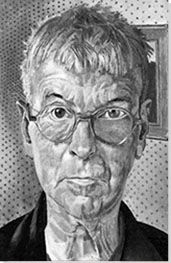Summary of Stanley Spencer
A highly eccentric and isolated figure, writers and art historians often brush quickly over Spencer's awkward and difficult work. He had two principle interests; sex and biblical narrative and the two sit quite jarringly and unsettlingly - sometimes even creating a perverse or sinister tone - when married explicitly together. Spencer's intention, like that of many artists, was to unite opposites - to align the body and spirit and the scared and profane in order to see the whole picture of life. However, in Spencer's case, personally obsessed with sex due to unsatisfactory relationships, and with religion etched on the mind having had daily Christian stories recited at home as a child, his depiction of such subjects come with added intensity.
Although Spencer studied at the Slade School of Art, he traveled home every evening to have dinner with his family and remained estranged from other influential artists of his day. He was profoundly affected by the experience of World War I, which shattered his insularity having previously only known the life of an idyllic childhood. As such, his story overlaps, at least in part, with that of the Polish-French painter, Balthus, who also uprooted from stability by the war, made particularly erotically charged pictures. Although Spencer himself often stated that he was trying to create peace and redemption in his paintings, the affect on the viewer can often, paradoxically, be one of writhing dystopia.
Accomplishments
- Spencer took the microcosm of his childhood village, Cookham in Berkshire, and explored its land and people in order to understand the macrocosm that is life, and the world, even to the extent of the heavens as well as the earth. The village residents became the characters in his painting and the landscape the stage setting for his mysterious scenes; he therefore successfully deals with universal themes coming from a local starting point.
- He was a master at creating large, heroic, and sprawling multi-figure compositions. Spencer's canvases are so complex and detailed that they resemble historical High Renaissance paintings, even early Renaissance frescos. His anatomical distortions and unusual perspective recall Mannerist paintings by the likes of Rosso and Jacopo da Pontormo. Whilst his piercing color palette looks back to the Post-Impressionists and Pre-Raphaelites, and his exquisite attention to detail looks forward to the portraits of Lucian Freud.
- Spencer's originality lay in his merging of the descriptively literal with the visionary and imaginative. During WWI he was given a copy of Saint Augustine's Confessions from which he took the idea that God is glorified by even the smallest and most menial tasks. As such, in one work, dustbin men become lovers, and in others laborers carrying ladders mimic Christ burdened by the crucifix.
- Revealing himself as a romantic (he admired the poetry of John Donne and William Blake), and with a specific active interest in the relations between men and women, Spencer openly investigates the physical as well as the spiritual side of love. He had various relationships and perhaps the most intense was with Patricia Preece, his second wife, a lesbian who denied Spencer sex and as such created irresolvable tensions and conflict between the desires of mind and body.
- As an ongoing project, the painter designed and worked towards "Church House", intended (although never built) as an enclosed sacred space made up of various chapel dedicated to his lovers, Preece, Hilda Carline (his first wife), Elise Munday, Daphne Charlton, and Charlotte Murray all included. This ongoing project further highlights the artist's pioneering interest in uniting explicit sex and religion, something quite common in Eastern devotion (for example, sacred temples in India decorated by the female yoni, symbol of the vagina), but considered shocking as relatively unheard of in Christianity.
The Life of Stanley Spencer
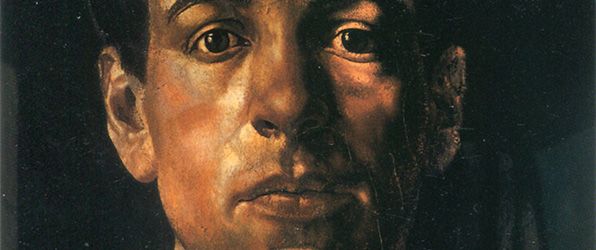
Sex-obsessed, jam-sandwich-eating, and outside-pajama-wearing - Stanley Spencer was the archetypal English eccentric. And his psychologically intriguing paintings represent an extension of this weird and wonderful personality.
Important Art by Stanley Spencer
The Apple Gatherers
With its vivid colors and tone of joie de vivre, the early influence of Post-Impressionism, and more specifically, of Gauguin is overriding in this early work. Although Spencer did not himself choose the subject - for it was specified that students of The Slade were to depict "Apple Gatherers" for their annual drawing competition - it does seem that, as is typical, the artist has infused an imagined scene with details from his own life. Spencer was one of nine children and here there are nine children and a monumental parental couple at the center. It seems clear then that this painting is a family portrait. Indeed, he did himself refer to the painting as "my first ambitious work and I have in it wished to say what life was". As is commonplace for the artist, he expressed within an everyday earthly scene, a pantheistic connection between man, woman, nature, and fertility. Picking fruits from the trees, the viewer is of course reminded of the literal Garden of Eden making thus Spencer's parents and the family that they create comparable to the first romantic union and the fruits that it bore, a metaphor for creation itself.
The central couple, with their arms entwined, metamorphose to become a stable and rooted tree. The image well professes the calm comfort of Spencer's childhood, anchored by the dual influence of his parents. Interestingly though, unity seems to give birth to division, for although the adult couple are bound together, the young girls and young boys turn their back upon one another, as though there is a lack of comprehension and involvement between the male and female characters of the next generation. This blindness in understanding between the sexes looks forward to Spencer's own failed love relationships, and also serves to make the painting seem more religious, recalling scenes of the righteous and unrighteous being divided before God in heaven. As an early work, the painting looks forward to themes that will recur throughout Spencer's career, and although loosely painted in the far ground, shows as well the tight and rigorous attention to detail of which he is capable in the foreground.
Oil on canvas - Collection of the Tate, United Kingdom
Self Portrait
This was Spencer's first self-portrait in oils and it is most interesting when viewed in comparison with the very similar full frontal portrait painted 50 years later. Painted when the artist was still young, we can just about see here the marked difference between Spencer's left and right eye. The later portrait clearly shows that the artist has two very different eyes and in this sense makes the profound comment that personalities are multiple and indeed sometimes split. It is the same moody and unpredictable inner psychological drama that the likes of Francis Bacon and Lucian Freud will go on to explore.
The portrait is testament both to the artist's skill and to his intense and determined character. As well as looking forward to art of the future, the influence of the Old Masters is incredibly clear in this work; the deep, dark background and the strongly modeled form is reminiscent of a work by Vermeer or Rembrandt. Indeed, Spencer was inspired to paint the portrait after seeing a reproduction of a head of Christ, by Luini, an Italian Renaissance artist. The portrait puts Spencer's face alongside the great and the good in the history of art, while by contrast, hung humbly for years in the front bedroom of Fernlea, the Spencer family home in Cookham-on-Thames.
Oil painting - Estate of Stanley Spencer
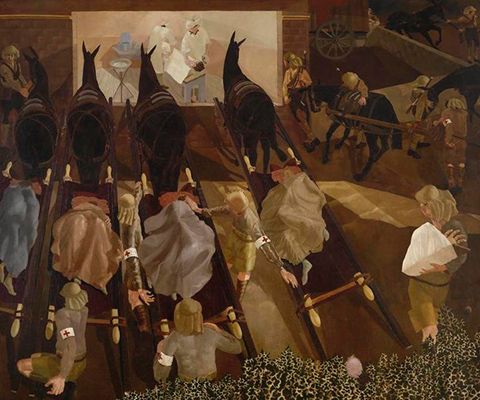
Travoys Arriving with Wounded at a Dressing-Station at Smol, Macedonia, September 1916
This muddy work, depicted in browns, blacks and ochres, shows men bringing wounded soldiers to a field hospital on stretchers. It was painted after Spencer returned from the war, and recalled his experience working with the field ambulances. Presented from an elevated position, we see four travoys brining in four casualties under blankets on stretchers. There is dynamism in the composition, in the medics' movement and in the way the wounded travel upwards, towards the light of the operating theatre in a clear spiritual reference. The hospital glows in hope of savior against the pessimism of the dark night. In the lower right corner of the frame a man walks away from the scene looking back at the hospital. His bandaged arm is lit up in positivity against the otherwise dark background.
The work came about after Spencer was approached by the British War Memorials Committee to produce an image of a religious service at the front. Accepting the commission, Spencer dismissed the suggested subject matter, opting instead to depict "'God in the bare real things, in a limber wagon, in ravines, in fouling mule lines." The scene shown was actually that of an old Greek church that had been converted into a temporary operating theater. Spencer wrote in a letter to his wife Hilda: "One would have thought that the scene was a sordid one... but I felt there was grandeur... all those wounded men were calm and at peace with everything, so the pain seemed a small thing with them."
Within the naive realism of this work, Spencer set a theme that would endure throughout his career, that of finding the spiritual in the everyday. He wanted this work to be a scene of redemption. As art historian Kitty Hauser said: "The world did not always please Spencer, or bend to his wishes, and in his art he sought to create a painted world that was not subject to the same laws as the real one. Here everything and everyone was redeemed."
Although this work owes something to European modernism, Spencer set himself apart at an early age. Hauser adds: "The simplified forms and bold use of color of his early work have something in common with Gauguin in particular. But Spencer's insistence on the importance of subject-matter separated him from those modernist painters who were his contemporaries in London and Paris."
Oil on Canvas - The Imperial War Museum, London
The Resurrection in Cookham Churchyard
This strange, haunting, and convoluted painting was the work that brought fame and critical acclaim to Spencer. The cinematic canvas, measuring 2.7 meters by 5.4 meters, showed the churchyard in his beloved hometown of Cookham-on-Thames in a scene of glorious reawakening. Tombs and coffins spring open as the dead stretch out, yawning from their slumber. The resurrected embrace one another; help each other up and converse in a happy (if only imagined) scene of rebirth. Sheltered by the church's porch is Jesus Christ, cradling three babies, while God stands behind. The artist can be spotted at the pinnacle, in the center middle ground, naked and relaxed, his modesty preserved by a tree as in Eden. In the foreground on a bed of ivy his soon-to-be wife Hilda lies asleep. To the far left, a boat transports the risen across the river to heaven against a golden sky. This is an idyllic scenario where Spencer asserts that even death can be re-imagined.
The work provides an interesting mix of styles - Cubism, Mannerism, and Realism - all worth a mention in a composition so complex that could have been devised by Giotto. Art critic, Keith Bell, writing in 1927, said: "What makes it so astonishing is the combination in it of careful detail with modern freedom in the treatment of form. It is as if a Pre-Raphaelite had shaken hands with a Cubist."
A deeply spiritual and optimistic man, Spencer wanted to make peace with all the contradictions of the world in his own way. As art historian Kitty Hauser said: "His aim was to fuse together in his work things that are everywhere separated: the sacred and the profane, religion and sex, the real and the imaginary, love and dirt, public and private, the young and the old, the self and others, the heavenly and the earthbound." For Spencer, everything is connected, everything holy, and everything one.
Oil on canvas - Collection of the Tate, United Kingdom
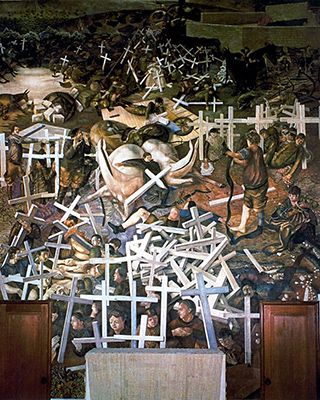
The Resurrection of the Soldiers
Known to some as Britain's Sistine Chapel, the Sandham Memorial Chapel contains a set of remarkable murals by Spencer produced in homage to Lieutenant Harry Sandham who was killed in the Battle of Salonika in World War I, at which Spencer himself had served as an orderly. Spencer carried out the work for the Behrends family, and Spencer, who was fascinated with the murals of the Scrovegni Chapel in Padua, reportedly exclaimed "What Ho, Giotto," when the commission came in. Spencer worked on the chapel for years as a way of processing and remedying the horrors of war, a sort of early version of art therapy. The murals show conflict and injury, as well as the more everyday aspects of warfare; soldiers eating, sleeping and having their injuries tended to.
The centerpiece in the chapel, The Resurrection of the Soldiers, brings together the sacred and the profane in Spencer's unique way. A dull gray and brown Macedonian battlefield landscape takes up the majority of the mural - Spencer would often omit sky or provide a high horizon to contain the work - which is strewn with the dead and dying. Animals lay stricken on the ground and strewn around are the bricks and panels of destruction. However, a closer look reveals that the infantrymen are in the process of being re-born; this is in fact another of Spencer's favored theme - that of resurrection. The soldiers meet, shake hands, and untangle themselves from barbed wire and bandages. The white crosses of Europe's mass cemeteries become crucifixes that the men can carry Christ-like in their salvation. In the middle a man is snuggled between two mules in the centre of the huge work, representing the artist's memory of being comforted by his parents in bed after being woken by a bad dream. Above him, dressed in white, is the figure of Jesus, handing out the crosses.
Spencer was a pacifist, and through this work he is offering love as redemption. As art historian Andrew Graham-Dixon said: "This is not so much a war memorial as an amelioration of war in art. The Resurrection of the Soldiers, showing a throng of bodies pressing up out of their graves, was Spencer's way of digging up the cemeteries of northern France, at least in his imagination, and bringing the young bodies of a dead generation back to life again." In art, he shows that anything is possible, time can be rewound and reality effaced. In the picture, Spencer could live in the imaginary perfect world that he so longed for.
Oil on canvas - Sandham Memorial Chapel, Hampshire, UK
The Dustman (or The Lovers)
This colorful and bustling composition shows Spencer creating a "sex heaven" out of his beloved Cookham. The picture presents characters from his hometown engaged in a bizarre bin collection day scene with deliberate sexual overtones. Heavy, stylized figures fill the canvas. In the centre is the dustman of the work's title looking heavenwards. He is being held in the arms of his wife, who is in a state of sexual ecstasy. To the right stands a white bearded man, representing the artist's father "Pa". All of the figures are surrounded by the trappings of English countryside; elaborate topiary, fruit and vegetables, a white picket fence, and the quaint latticed lead work of the cottage in the background.
Spencer said of the painting that it was like "watching the inside of a sexual experience". As indicated by the work's alternative name, The Lovers, the work intentionally "treads a thin line between spiritual transportation and sexual ecstasy", according to art historian Kitty Hauser. She said: "Spencer came to imagine the 'Last Day' as a day on which all differences would be erased, social, sexual boundaries would be crossed, as we would all dissolve into each other in orgies of sensual bliss." This would be a recurrent motif in the artist's work, explored in other works such as Love on the Moor and Sarah Tubb and the Heavenly Visitors (1933).
The legacy of the Renaissance is also clear in this work. As art writer Skye Sherwin said: "Although Spencer is often compared to another English visionary, William Blake, his artistic touchstone was Giotto. His figures have both the volume and stagey otherworldliness of the master's." The painting was intended for the artist's ongoing project, the "Church House", whereby he would unite scenes of sex and devotion. There is however also a real sense of the grotesque to this picture, which aligns it in both style and subject matter to the German Expressionist painters active in Berlin between the wars.
Oil on canvas - Tyne and Wear Museums, Northumbria, UK
Self-portrait with Patricia Preece
This double nude portrait shows Spencer apparently on his knees in front of his lover Patricia Preece, who is lying down in bed. In his pose he submits to her, bringing himself to her eye line, but she does not look at him, instead staring indifferently into the middle distance. The composition is nearly entirely full of the two bodies, a move that was characteristic of Spencer as he tried to evoke a sense of containment within his works - which here comes across as claustrophobic. The technique is one further explored by both Lucian Freud and Jenny Saville. There is also a sense of the domestic present here, an important theme throughout Spencer's work, shown in the soft, silvery sheets, the curlicues of the bed frame, and the decorative floral wallpaper. Preece is rendered in warm fleshy tones, almost foreshadowing photorealism, which do not match her cold expression. The artist's body meanwhile, matches the cool tones of the sheets. His skin is greenish, white and cadaverous, with the only blood flow depicted in his face, perhaps suggesting sexual excitement, or that only his mind (and not his body) is satisfied by this relationship.
The work is autobiographical; Spencer was infatuated with Preece, a woman who it seems was more interested in his financial value than anything else. They spent one night together after their wedding, when he signed over the deeds to his house, before Preece returned to her lover. Their marriage was never consummated. Nevertheless, Spencer said he suffered from a sort of 'religious fervour' for her, and this is one of two double nude portraits that he painted of the two of them. The other, Double Nude Portrait: The Artist and his Second Wife (1937), also known as the Leg of Mutton, was considered too explicit to be exhibited in the artist's lifetime.
Spencer was often referred to as a visionary and a man whose work was deeply psychological. A reading of this work suggests that through his painting, the artist was expressing things he was not aware of at a cognitive level; Spencer's love for Preece was unrequited. As art historian Sister Wendy Beckett, said: "This is an interesting instance of an artist painting what he subliminally knows well, but intellectually doesn't. At some level he knows they can never be mates. His art understands, but he doesn't understand." Or perhaps, as art is Spencer's canvas for making fantasies real, the only place that he can in fact be with Preece, is in his paintings.
Oil on canvas - The Fitzwilliam Museum, Cambridge, UK
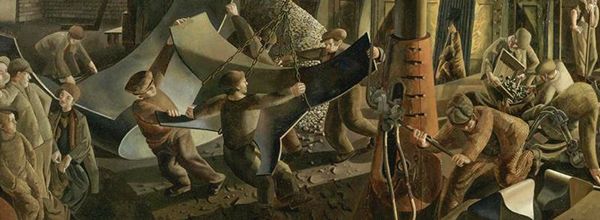
Shipbuilding on the Clyde, Bending the Keel Plate
This enormous work measures nearly six meters across and illustrates the process of building a ship. On the far left, four men steer a sheet of steel hanging from chains attached to a crane, while a man hammers a steel sheet in the foreground. As the eye moves across the canvas, other scenes of industry are shown; men work on a red-hot shoe plate which has just emerged from the furnace; two men lever up sheet steel from a pile; a group of men carry a steel girder; a man seated on a bench works on angled pieces of steel. An unpleasant and noisy environment in reality, Spencer creates harmony through the repeated shapes, the smooth surfaces and the carefully choreographed figures.
The work was ambitious; it was nearly abandoned and Spencer was unhappy with the final painting. It was commissioned during the outbreak of WWII by the War Artists Advisory Committee and raises shipyard workers to heroic status as they go about their everyday labor. In this way, the picture is in some ways reminiscent of the Socialist Realism of Russia, which under the Stalinist Government's watchful eye, produced propagandist works deifying the ordinary in a bid to increase national production. Unlike the Social Realists however, Spencer said the work was intended to be liberating, and reportedly found the busy industry of the Glasgow shipyards "homely". In his own irreproducible tone and style, he bestowed an almost religious aspect onto the men as they worked tirelessly at the furnace. The work further shows Spencer's skill at navigating large multi-figure compositions, as well as his love of combining so-called opposites -- dirt and glory, the earthly and the profound, and the everyday and the spiritual.
Oil on Canvas - The Imperial War Museum, London
Biography of Stanley Spencer
Childhood
Stanley Spencer was the second youngest of nine children born to William and Anna Spencer. He was born in Cookham-on-Thames, a quaint village in Berkshire that was to become an integral subject throughout his work. His family had a long history in the area; his grandfather had built a number of buildings in Cookham, including the villa in which Stanley was born. It was attached to an identical house, in which the artist's cousins lived. He was brought up a Methodist, and his spirituality would always have heavy bearing on his artistic output.
William Spencer worked as a builder initially, but he later earned a living as a teacher and musician. The family were creative; they loved playing instruments and performing, and were also devout; taking it in turns to read from the bible each day. Spencer and his younger brother Gilbert (who also became a notable artist) were both home-schooled by their father and sisters, leaving time from an early age to draw and develop their artistic skill. Stanley would sketch scenes from Cookham and also copy illustrations from his father's vast library. He was especially inspired by the children's illustrator, Arthur Rackham, and found his calling to art as a child.
Early Training and Work
Spencer's first formal training came from a local artist called Dorothy Bailey, who taught both him and his brother Gilbert how to successfully use watercolors. When he was 15, Stanley enrolled at the Technical Institute in Maidenhead, before moving to the prestigious Slade School of Fine Art in London the following year, which he would commute to via train every day from Cookham. Spencer studied at The Slade between 1908-1912 where he became a skilled draughtsman having spent hours studying statues and drawing from life models. His contemporaries included the likes of Dora Carrington, Paul Nash, and David Bomberg, but he didn't build lasting friendships with any of them.
He did however exhibit the painting John Donne Arriving in Heaven (1911) and some drawings at Second Post-Impressionist Exhibition, organized by Roger Fry. Furthermore, the immediate three years that followed having left The Slade saw what was arguably the most productive period of Spencer's artistic life. Looking back on it, he referred to it as his "Golden Age", a period when his vision was most intense and when he produced his best work. "When I left Slade, and went back to Cookham, I entered a kind of earthly paradise," he said.
He wrote at the time:
"I feel fresh awake and alive; that is the time for visitations. We swim and look at the bank over the rushes I swim right in the pathway of sunlight I go home to breakfast thinking as I go of the beautiful wholeness of the day. During the morning I am visited and walk about being in that visitation."
The paradise was not to last long for shortly afterwards came the outbreak of World War I. Spencer joined the Royal Army Medical Corps, where he worked as an orderly at the Beaufort War Hospital near Bristol. The following year he was posted to Macedonia and in 1917 he became an infantryman in the 7th Battalion of the Royal Berkshires in the Balkans. He spent more than two years on the front line, but was sent home after contracting Malaria. He did not paint during the war, but on his return to Cookham when the conflict was over, he produced a number of works recalling his service.
Mature Period
The early 1920s marked a period of great psychological change for the young Spencer, changes which have been attributed both to his traumatic experiences in war, and to his new burgeoning romantic life. His love life, which although started late, quickly grew in intensity and complexity. He was reportedly a virgin until his thirties and said that the first time he touched a woman that it felt as though he was performing a miracle (again the union of sex and religion). In December 1919, Spencer met Hilda Carline who came from a family of artists. He proposed to her on a painting holiday in Bosnia and then reportedly broke off the engagement multiple times before they finally married in Suffolk in February 1925. A few months later, their first daughter, Shirin, was born and the couple moved to Burghclere in Hampshire.
In 1927, Spencer exhibited his breakthrough work The Resurrection, Cookham (1924-27) at London's Goupil Gallery and received great critical acclaim. In 1930, Hilda gave birth to their second child, Unity. Sadly though, the domestic bliss of the family's early years soon faded as Spencer suffered with recurring painful kidney stones and it is likely that Hilda suffered from depression. Spencer was an emotionally demanding man to live with. He was described as "small and wiry" with a "very energetic yet engaging personality". According to the Stanley Spencer Gallery: "He could also be quite exhausting and would talk for hours with his mind flying free." He talked so much that Hilda would occasionally fall asleep while listening to him.
From the early 1930s onwards, Spencer's work became increasingly preoccupied with sex, as his own personal affairs became more unusual and multiple. Critics were dismissive of the works produced during this period, and despite being a member of the Royal Academy, the institution rejected two of Spencer's paintings, and so the artist resigned from the academy feeling misunderstood.
Spencer had moved his family back to Cookham in 1932, which is the same moment that he became utterly infatuated with the younger and very glamorous artist Patricia Preece, whom he had met a couple of years before. Spencer was still married to Hilda, and Preece was in a relationship with another artist, Dorothy Hepworth. Therefore, instead of embarking on a romantic relationship at this time, Preece became Spencer's agent, and she encouraged him to produce more landscapes for which he was well paid. Spencer though, continued to woo Preece, spending thousands on clothes, furs and jewelry for his love, all the while expecting his wife and children to survive on only 30 shillings per week. After years of struggle, and humiliation for Hilda, she and Spencer finally divorced in 1937. Four days later, despite the fact that Patricia was a lesbian, she and Spencer married.
Different accounts exist for what happened next, but according to art historian Kitty Hauser, Spencer had always planned to continue his relationship with both Hilda and Patricia. Before the second couple's honeymoon in the artists' hub of St Ives, Spencer slept with his first wife. On learning this, Patricia was reportedly furious, and refused to stay in Spencer's room. Instead, she stayed with Dorothy, who had joined them on the Cornwall trip. Preece in fact refused outright to ever have sex with Spencer, and indeed, the marriage was never consummated.
Spencer said of the situation: "The law does not allow me to have two wives. Yet I must and I will have two." It seemed though, that his fantasy and reality did not align here and by 1938 both women had rejected him. He was being chased by Hilda's solicitor for maintenance payments, and by the Inland Revenue for tax contributions. Spencer was distressed and considered suing the War Office for compensation for what he had suffered in service.
By 1942 Spencer asked Hilda to remarry him but she refused, saying "You are too much of an artist to have satisfactory relations with any woman." The pair continued to be close however and Spencer would write to her often - every day sometimes. She was later admitted to a psychiatric hospital for nine months. In 1947 she was diagnosed with breast cancer and she died in 1950, with her husband at her side. The two were even buried together in Cookham cemetery, with the inscription beneath their headstone reading, "Everyone that loveth is born of God and knoweth God he that loveth not knoweth not God for God is love".
Late work
Spencer's landscapes were popular with the art buying public, but he was by no means passionate about making them. He described them as "dead, dead", but continued to produce them because they were lucrative. Painting landscapes en plein air he said made him feel lonely and he wanted instead to produce pictures that explored the intricate and gritty relations between figure and place.
After the war, Spencer struggled to return to the contentment of his now much earlier "golden age". His eccentricities became more pronounced; known to wear his pajamas under his suit if it was cold, eating mainly jam sandwiches, and often seen wandering the lanes of Cookham pushing an old pram in which he carried his canvas and easel. He also became itinerant, and would spend much of his adult life staying at different friends' houses. Without the comforting domestic security of his early years, his visions were harder to access. He would obsessively make records of his paintings, writing lists of them, and cataloguing them in reference to themes or sequences.
During the 1940s and 1950s Spencer's work fell out of favor with some, and was criticized for its form and technique. Artist and critic Wyndham Lewis cruelly wrote about Spencer's "aggressively corpulent" women and his "lower-middle-class" subject matter. He added: "He is endlessly repetitive. One feels he could turn out a thousand figures as easily as a hundred, it would take him ten times as long that is all." This seems unnecessarily harsh in many respects and missing much of Spencer's skill. Luckily though, he did remain popular with many, and in 1950 Spencer was reinstated at the Royal Academy. In 1959, in recognition of the artist's overwhelming achievements and rich career, he was awarded the highest honor of knighthood.
Spencer was also a prolific writer, fascinated with self-analysis, and he would write in his journals every day. In December 1958 Spencer was diagnosed with cancer and he died a year later at the Canadian War Memorial Hospital in Cliveden, Berkshire, having worked right up to his death. When he died, he left several trunks full of notebooks, diaries, letters, lists and other writing, later acquired by the Tate.
The Legacy of Stanley Spencer
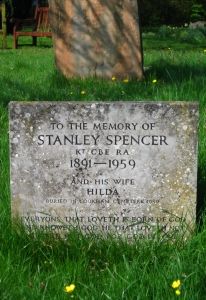
Spencer's work can be charming in its optimism, but equally it can be haunting in the unreachable demands that it highlights in terms of attachment and relationships. His style, in many ways seems to mirror the artist's childlike idealism. However, cultural historian Fiona McCarthy warns: "To see him as an unschooled primitive, a Home Counties Alfred Wallis, would be absolutely wrong. He trained at the Slade, then the leading London art school, in a pre-first world war generation that included Edward Wadsworth, Paul Nash, David Bomberg, and Mark Gertler. Spencer was singled out by the Slade's famous teacher of drawing, Professor Henry Tonks, as the most original of all Slade students, and his precocious work was included in the Second Post-Impressionist Exhibition in 1912, shown alongside paintings by Matisse, Picasso and Cézanne."
Indeed, it is important that Spencer's work is examined within its own historical context. The sexual overtones of his work may seem relatively tame by today's media standards, but at the time things were very different. It has been reported that in 1950, the outgoing president of the Royal Academy, Sir Alfred Munnings, acquired some of Spencer's scrapbook drawings and initiated a police prosecution against Spencer for obscenity, which was only dropped once the pictures had been destroyed.
Arguably though, Spencer was in no way perverse, but more of a visionary. His fascination with his own life and psychology, as well as his unflinching representation of obsessive (sometimes dangerous) personality traits looked forward to a new and emerging trend in British art that would include the work of Lucian Freud, Francis Bacon, and Frank Auerbach. Like the above, and also notable, Alice Neel, Spencer was a majestic portrait painter. There are not many artists that can capture the sensitive, acute, and delicate likeness of a sitter, whilst encompassing both the light and dark side of a personality.
Hauser said: "Since his death, his critical reputation has fluctuated, according to the broader fortunes of figurative painting and narrative art. Until the 1970s, his willful parochialism meant that writers could only accommodate him into an art history dominated by modernism, by aligning him with a lineage of visionary 'outsiders' in British art, notably William Blake." More open-minded and less definite recent decades have seen resurgence in his popularity, and in the past forty years, Spencer's work has been exhibited in Britain, Europe, and America. His legacy also lives on in the Sandham Memorial Chapel in Burghclere, Hampshire, and in the talent of his daughter, Unity Spencer, who also became an accomplished artist in her own lifetime.
Influences and Connections

-
![John Everett Millais]() John Everett Millais
John Everett Millais -
![Giotto]() Giotto
Giotto -
![Paul Gauguin]() Paul Gauguin
Paul Gauguin - Arthur Rackham
- Le Fanu
- Hilda Carline
- Henry Lamb
- Henry Tonks
-
![The Pre-Raphaelites]() The Pre-Raphaelites
The Pre-Raphaelites -
![Post-Impressionism]() Post-Impressionism
Post-Impressionism - italian_renaissance
-
![Lucian Freud]() Lucian Freud
Lucian Freud -
![Peter Blake]() Peter Blake
Peter Blake - Anthony Green
- Beryl Cook
- Robert Senior
- Unity Spencer
- Mark Gertler
-
![Post-Impressionism]() Post-Impressionism
Post-Impressionism - Brotherhood of Ruralists
 Ask The Art Story AI
Ask The Art Story AI